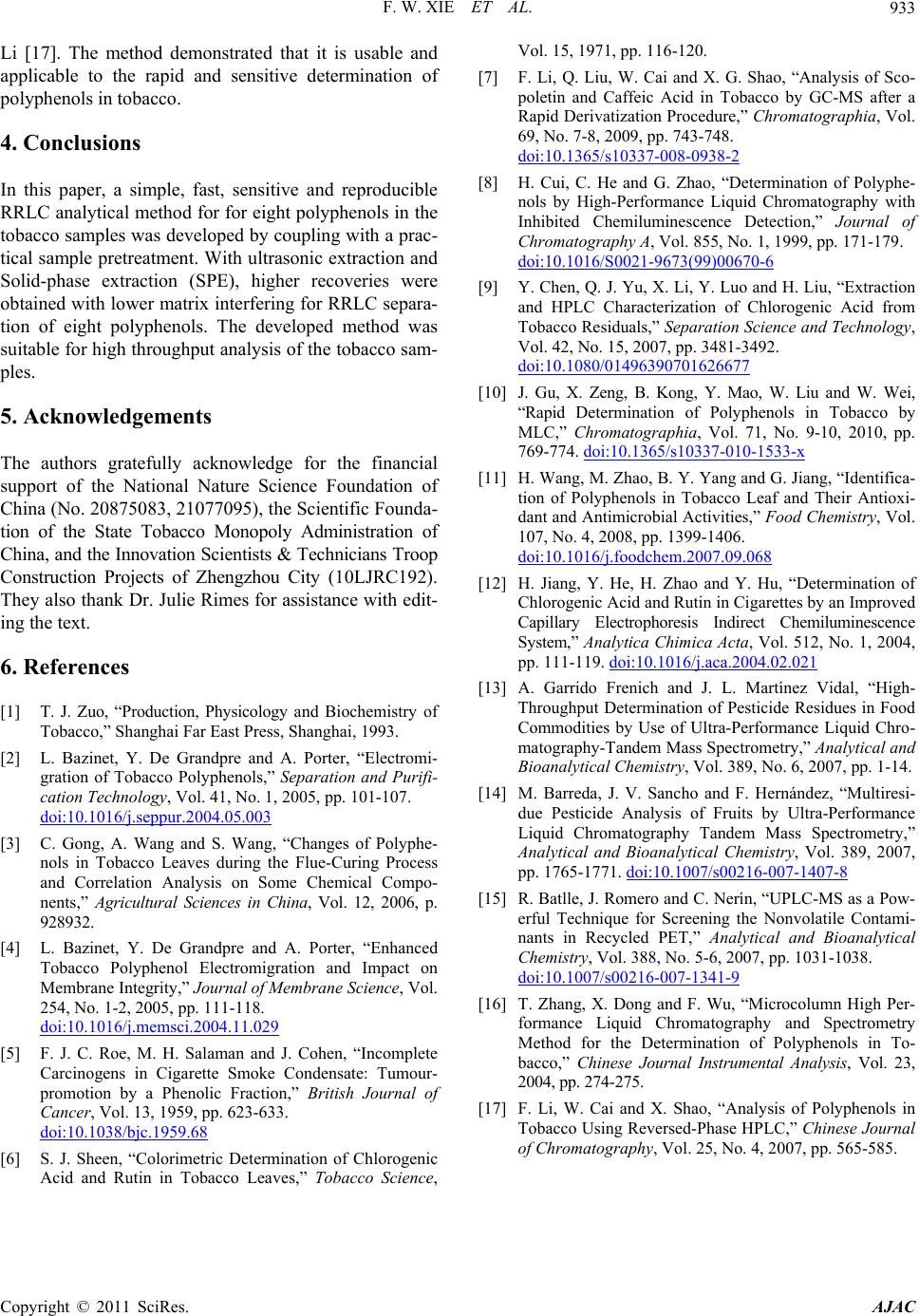
F. W. XIE ET AL.
Copyright © 2011 SciRes. AJAC
933
Li [17]. The method demonstrated that it is usable and
applicable to the rapid and sensitive determination of
polyphenols in tobacco.
4. Conclusions
In this paper, a simple, fast, sensitive and reproducible
RRLC analytical method for for eight polyphenols in the
tobacco samples was developed by coupling with a prac-
tical sample pretreatment. With ultrasonic extraction and
Solid-phase extraction (SPE), higher recoveries were
obtained with lower matrix interfering for RRLC separa-
tion of eight polyphenols. The developed method was
suitable for high throughput analysis of the tobacco sam-
ples.
5. Acknowledgements
The authors gratefully acknowledge for the financial
support of the National Nature Science Foundation of
China (No. 20875083, 21077095), the Scientific Founda-
tion of the State Tobacco Monopoly Administration of
China, and the Innovation Scientists & Technicians Troop
Construction Projects of Zhengzhou City (10LJRC192).
They also thank Dr. Julie Rimes for assistance with edit-
ing the text.
6. References
[1] T. J. Zuo, “Production, Physicology and Biochemistry of
Tobacco,” Shanghai Far East Press, Shanghai, 1993.
[2] L. Bazinet, Y. De Grandpre and A. Porter, “Electromi-
gration of Tobacco Polyphenols,” Separation and Purifi-
cation Technology, Vol. 41, No. 1, 2005, pp. 101-107.
doi:10.1016/j.seppur.2004.05.003
[3] C. Gong, A. Wang and S. Wang, “Changes of Polyphe-
nols in Tobacco Leaves during the Flue-Curing Process
and Correlation Analysis on Some Chemical Compo-
nents,” Agricultural Sciences in China, Vol. 12, 2006, p.
928932.
[4] L. Bazinet, Y. De Grandpre and A. Porter, “Enhanced
Tobacco Polyphenol Electromigration and Impact on
Membrane Integrity,” Journal of Membrane Science, Vol.
254, No. 1-2, 2005, pp. 111-118.
doi:10.1016/j.memsci.2004.11.029
[5] F. J. C. Roe, M. H. Salaman and J. Cohen, “Incomplete
Carcinogens in Cigarette Smoke Condensate: Tumour-
promotion by a Phenolic Fraction,” British Journal of
Cancer, Vol. 13, 1959, pp. 623-633.
doi:10.1038/bjc.1959.68
[6] S. J. Sheen, “Colorimetric Determination of Chlorogenic
Acid and Rutin in Tobacco Leaves,” Tobacco Science,
Vol. 15, 1971, pp. 116-120.
[7] F. Li, Q. Liu, W. Cai and X. G. Shao, “Analysis of Sco-
poletin and Caffeic Acid in Tobacco by GC-MS after a
Rapid Derivatization Procedure,” Chromatographia, Vol.
69, No. 7-8, 2009, pp. 743-748.
doi:10.1365/s10337-008-0938-2
[8] H. Cui, C. He and G. Zhao, “Determination of Polyphe-
nols by High-Performance Liquid Chromatography with
Inhibited Chemiluminescence Detection,” Journal of
Chromatography A, Vol. 855, No. 1, 1999, pp. 171-179.
doi:10.1016/S0021-9673(99)00670-6
[9] Y. Chen, Q. J. Yu, X. Li, Y. Luo and H. Liu, “Extraction
and HPLC Characterization of Chlorogenic Acid from
Tobacco Residuals,” Separation Science and Technology,
Vol. 42, No. 15, 2007, pp. 3481-3492.
doi:10.1080/01496390701626677
[10] J. Gu, X. Zeng, B. Kong, Y. Mao, W. Liu and W. Wei,
“Rapid Determination of Polyphenols in Tobacco by
MLC,” Chromatographia, Vol. 71, No. 9-10, 2010, pp.
769-774. doi:10.1365/s10337-010-1533-x
[11] H. Wang, M. Zhao, B. Y. Yang and G. Jiang, “Identifica-
tion of Polyphenols in Tobacco Leaf and Their Antioxi-
dant and Antimicrobial Activities,” Food Chemistry, Vol.
107, No. 4, 2008, pp. 1399-1406.
doi:10.1016/j.foodchem.2007.09.068
[12] H. Jiang, Y. He, H. Zhao and Y. Hu, “Determination of
Chlorogenic Acid and Rutin in Cigarettes by an Improved
Capillary Electrophoresis Indirect Chemiluminescence
System,” Analytica Chimica Acta, Vol. 512, No. 1, 2004,
pp. 111-119. doi:10.1016/j.aca.2004.02.021
[13] A. Garrido Frenich and J. L. Martínez Vidal, “High-
Throughput Determination of Pesticide Residues in Food
Commodities by Use of Ultra-Performance Liquid Chro-
matography-Tandem Mass Spectrometry,” Analytic al and
Bioanalytical Chemistry, Vol. 389, No. 6, 2007, pp. 1-14.
[14] M. Barreda, J. V. Sancho and F. Hernández, “Multiresi-
due Pesticide Analysis of Fruits by Ultra-Performance
Liquid Chromatography Tandem Mass Spectrometry,”
Analytical and Bioanalytical Chemistry, Vol. 389, 2007,
pp. 1765-1771. doi:10.1007/s00216-007-1407-8
[15] R. Batlle, J. Romero and C. Nerín, “UPLC-MS as a Pow-
erful Technique for Screening the Nonvolatile Contami-
nants in Recycled PET,” Analytical and Bioanalytical
Chemistry, Vol. 388, No. 5-6, 2007, pp. 1031-1038.
doi:10.1007/s00216-007-1341-9
[16] T. Zhang, X. Dong and F. Wu, “Microcolumn High Per-
formance Liquid Chromatography and Spectrometry
Method for the Determination of Polyphenols in To-
bacco,” Chinese Journal Instrumental Analysis, Vol. 23,
2004, pp. 274-275.
[17] F. Li, W. Cai and X. Shao, “Analysis of Polyphenols in
Tobacco Using Reversed-Phase HPLC,” Chinese Journal
of Chromatography, Vol. 25, No. 4, 2007, pp. 565-585.